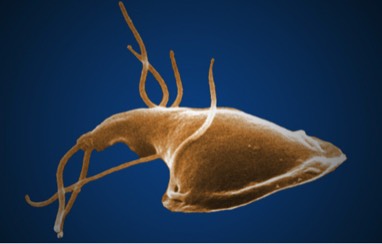May 2011
Airing divergent views has always seemed to me a worthy endeavor. For the sake of focus, let’s confine the discussion to protozoa and not wander off into viruses and bacteria, which entail different field water treatment approaches. I’ll just get us started with a little background . . .

Giardia is a microscopic parasite that causes the diarrheal illness known as giardiasis. Image taken from the CDC Web site.
Seemingly, to complicate matters, it’s possible for a person to have Giardia and not know it. Such individuals are called “asymptomatic carriers” and, although they remain untroubled by symptoms and do not appear ill, they can pass along the affliction. The waterborne dormant cyst stage of Giardia is what’s known to survive in field water, particularly cold water, for long periods of time. Many animals carry strains of Giardia, and it’s an unfinished story as to which are zoonotic (passed from animal to human). Lucky for us, a filter with an absolute pore size of 3.0 microns will screen out all protozoan cysts.
For some thirty years now, the U.S. Center for Disease Control & Prevention has not guaranteed that any of the world’s surface water is Giardia-free. And yet, that doesn’t mean every bucketful scooped from a stream contains cysts.
As the breathing repository of countless divulged shitty stories, I hereby offer a couple of pertinent fringe observations. (1) Blanket statements when issued by a federal agency have a tendency to spark, especially among us fiercely independent (I won’t say anarchical) outdoor sorts, an automatic contrary opinion, coupled with the ineluctable challenge to disprove. (2) The sunny-of-heart high-country trekker—or determined “go-lighter” (term for trimming down gear to a minimal few pounds)—will sometimes pride herself on scouting out trustworthy headwaters and not having to tote a field water treatment kit. If she/he can do it, could not we all?
As usual, not much but pore size is absolute, or even simple. Got an opinion? Jump in. Survived Giardia, yourself? Share some details (anonymously, if you prefer).


May 2011
Airing divergent views has always seemed to me a worthy endeavor. For the sake of focus, let’s confine the discussion to protozoa and not wander off into viruses and bacteria, which entail different field water treatment approaches. I’ll just get us started with a little background . . .

Giardia is a microscopic parasite that causes the diarrheal illness known as giardiasis. Image taken from the CDC Web site.
Seemingly, to complicate matters, it’s possible for a person to have Giardia and not know it. Such individuals are called “asymptomatic carriers” and, although they remain untroubled by symptoms and do not appear ill, they can pass along the affliction. The waterborne dormant cyst stage of Giardia is what’s known to survive in field water, particularly cold water, for long periods of time. Many animals carry strains of Giardia, and it’s an unfinished story as to which are zoonotic (passed from animal to human). Lucky for us, a filter with an absolute pore size of 3.0 microns will screen out all protozoan cysts.
For some thirty years now, the U.S. Center for Disease Control & Prevention has not guaranteed that any of the world’s surface water is Giardia-free. And yet, that doesn’t mean every bucketful scooped from a stream contains cysts.
As the breathing repository of countless divulged shitty stories, I hereby offer a couple of pertinent fringe observations. (1) Blanket statements when issued by a federal agency have a tendency to spark, especially among us fiercely independent (I won’t say anarchical) outdoor sorts, an automatic contrary opinion, coupled with the ineluctable challenge to disprove. (2) The sunny-of-heart high-country trekker—or determined “go-lighter” (term for trimming down gear to a minimal few pounds)—will sometimes pride herself on scouting out trustworthy headwaters and not having to tote a field water treatment kit. If she/he can do it, could not we all?
As usual, not much but pore size is absolute, or even simple. Got an opinion? Jump in. Survived Giardia, yourself? Share some details (anonymously, if you prefer).

© 2011 by Author Kathleen Meyer • All Rights Reserved
Web site design by RapidRiver.us
© 2011 by Author Kathleen Meyer • All Rights Reserved
Web site design by RapidRiver.us
